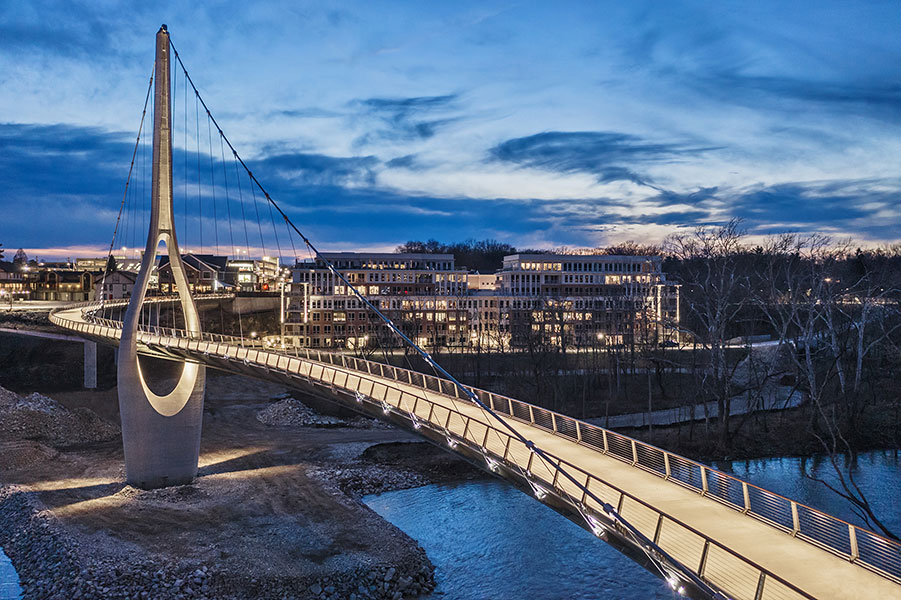A pedestrian bridge is stitching landscapes together in OhioBy Michele Zimmerman
Photo: Cory Klein Photography
There is no need to search for this needle: a new 760-ft long pedestrian bridge in Dublin, OH, in the curved shape of “thread” through the “eye of a needle” is bright and clear for all to see. Completed in March 2020 at a design cost of $3.85 million and a construction cost of $22.6 million, the Dublin Link—like your favorite garment—is not only eye-catching, it’s practical. The walkway ties together the east and west sides of the city divided by the Scioto River and serves as a way to bring newcomers to the location. Designers from Lighting Design Alliance (LDA), Los Angeles, were tasked with creating the unique structure that lets locals and tourists alike travel from the commercial and residential center of Dublin to a new park development.
Designing the illusion of the seemingly floating bridge was also the biggest challenge of the project. LDA’s Matthew Bates, lead lighting designer, says his team needed to figure out “how to best integrate architectural light fixtures into the structural design, so that the people using the bridge notice the lighting effects but do not see the light source.” He broke down the design strategy, like the instructions of a sewing pattern, into parts: walkway illumination, the needle and support-cable accents.
For walkway illumination, lighting integrated into handrails was imperative. Warm-white LEDs at 3000K on a dimming system (set to a 1 footcandle average) helped designers to achieve “as even a lighting effect as possible across the main surface,” says Bates. “The light fixtures were specified with asymmetric optics so the fixtures throw light into the center of the walkway. The asymmetric lighting also preserves the ‘dark environment’ of the nature below the bridge, and helps limit views of the bright light sources. The optics also allow for a max/min ratio of 2:1.” As the fixtures in the guardrail system are hand height, the light sources are not visible to passersby.
For the needle—the main pylon—designers integrated RGBW LED striplights with dynamic color-changing capabilities into the inner surface where the bridge and pedestrians pass through the “eye.” To illuminate the vertical surface of the “pin”—the exterior of the needle—designers implemented washes of light coming from the sides of the structure wall. Bates explains, “the structure wall is concrete; we had to coordinate mounting details early on that would conceal the linear light source.”
The support-cable accents of the bridge are also equipped with LED RGBW color-changing effects in order to be able to coordinate thematically and visually with the needle. “The color-changing floodlights mounted on the side structure of the bridge for the illumination of the support cables connecting to the main support cable had to be concealed in the structure,” says Bates. “With the curve in the bridge walkway, the pedestrian gets more views of the side structure than they would normally on a straight bridge—we had to be more conscious of the potential views of fixtures.” These dynamic lights allow for the Dublin Link to be stitched into the fabric of the city it serves by participating in seasonal themes, holidays, sporting events and more. The operations team of the bridge has the ability to set the colors as needed through a control system that includes an astronomical timeclock.
The LDA team set out to craft something iconic: a New-York-Fashion-Week of a connecting bridge with an Ohio flair, a bespoke visual impact and a social statement of togetherness. Bates, now sewn into the history of the state, specified that his favorite part of working on the project was knowing that the bridge—a thread to the future—would impact people’s lives for years to come, especially at night.
THE DESIGNERS
Matthew Bates is senior designer with LDA.
Chip Israel, Fellow IALD, LC, LEED AP, Fellow IES, is CEO and founder of LDA.


